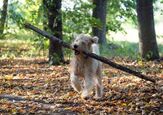Is Your Dog at Risk for IVDD? A Guide to Breeds and Prevention

We all love seeing our dogs living their best possible lives, one full of happy zoomies, comfortable naps, and pain-free adventures. But to make that a priority, we must also familiarize ourselves with the common health conditions each breed may face and how to keep our pup safe. One such condition worth being fully informed about is Intervertebral Disc Disease (IVDD).
While the medical name of this condition may sound intimidating, it’s an all-too-common spinal condition among some breeds that requires proactive care.
In this guide, I’ll break down what IVDD is, highlight the breeds that are at the highest risk, teach you how to recognize the signs (even the most subtle), and provide you with a clear, actionable plan for making changes in your home and daily routine that will help to significantly lower your dog’s risk. Think of this as your essential roadmap to protecting your dog.
What is Intervertebral Disc Disease (IVDD)?
To protect your dog’s back, it's helpful to first understand what’s happening underneath their fur. Think of your dog’s spine not just as a column of bone, but as a flexible, shock-absorbing system. More specifically, consider the cushioning intervertebral discs in the spine, the same discs that allow your dog to run, jump, and twist. These are specialized structures that sit between each bony segment of the spine.
Each disc is like a miniature, tough, fluid-filled pouch. It has a tough outer layer (like a tire wall) and a soft, jelly-like center. These discs serve an important role, cushioning the impact of your dog’s every movement. They also allow the spine the flexibility needed for your dog to move freely, including turning its head and arching its back.
Explaining IVDD
IVDD, sometimes referred to as a “slipped disc,” happens when these essential cushions break down and stop doing their job. It’s a progressive, degenerative condition, meaning it continues to get worse over time, especially if it’s left unaddressed.
- Degeneration: The first problem is often the disc itself. The jelly center begins to dry out, harden, and calcify. This causes the disc to lose its shock-absorbing ability and become brittle.
- Herniation (The Rupture): A degenerated disc is highly vulnerable. Any sudden force, or even normal movement over time, can cause it to either bulge or rupture.
- Spinal Cord Compression: When the disc material bulges or bursts, it pushes upward into the space occupied by the delicate spinal cord. This pressure is what causes the symptoms we see, ranging from agonizing pain to complete paralysis. The severity will depend on how much the material pushes out and how violently it impacts the cord.
The Two Main Types of IVDD
Veterinarians classify IVDD into two main types, named after the human pathologist, Hans Hansen. Understanding the type helps explain the onset and risk factors.
The first type is Type I IVDD, which is characterized by the sudden, explosive rupture of the hardened, jelly-like center. The onset is typically sudden, often triggered by a seemingly minor movement, like jumping. This type is most common in small, short-legged breeds, like the dachshund.
The second is Type II IVDD, which involves the slower, more gradual bulging of the outer ring of the disc into the spinal canal. The onset is slow and progressive, with symptoms that may appear as increasing stiffness or weakness over several months. Type II is typically seen in older, larger dogs.
High-Risk Dog Breeds
Any dog can develop IVDD, particularly as they get older. However, genetics and body shape mean that certain dog breeds carry a much higher risk, specifically to the acute Type I IVDD. By familiarizing yourself with your dog’s risk, you can better understand the need for prevention and how to keep your pup safe.
The Chondrodystrophic Predisposition
Dogs most vulnerable to Type I IVDD are those with a genetic trait called chondrodystrophy, which causes disproportionately short legs and long backs. This body type means there is constant, uneven stress placed on the dog’s spine. It has also been linked to premature degeneration and hardening of the spinal discs, which could cause them to rupture much earlier in life.
The following dog breeds are considered to be the most at-risk due to this body structure:
- Dachshunds: They are the poster child for IVD, with the highest prevalence of all breeds. Their extreme length and short legs make them highly susceptible to disc issues throughout the entire length of their spine.
- Corgis ( Pembroke and Cardigan): Not only do these dogs have a chondrodystrophic body shape, but they are also a highly active breed, which adds to the force put on their spine daily.
- French Bulldogs: While their bodies are not as long as a Dachshund, their compacted bodies and structure still put them at a higher risk, especially for issues in the cervical (neck) spine.
- Basset Hounds: Their heavy frames and short legs mean their spines are facing persistent stress, often leading to disc issues.
- Beagles & Miniature/Toy Poodles: These breeds don’t have the appearance that would raise a red flag as being an issue, but they do carry a genetic predisposition that puts them at a higher risk.
- Small “Fluffy” Breeds: Breeds like the Shih Tzus, Pekingese, and Lhasa Apsos are also genetically predisposed to trouble. In these breeds, IVDD is often experienced in the neck, causing severe pain and making it harder for them to lower their heads to eat or drink.
High Risk Breeds for Type II IVDD
While Type I IVDD is a genetic lottery for the breeds listed above, Type II IVDD is a little different. It’s much more similar to disc disease in humans, a slower, age-related degeneration that can affect any breed. That said, there are still some breeds that are at a statistically higher risk.
Older large-breed dogs, such as German Shepherds, Labrador Retrievers, and Doberman Pinschers, can develop Type II or IVDD. In these cases, the symptoms are often more gradual, appearing as subtle hind-end weakness, stiffness, or an unsteady gait. It’s not uncommon for it to be mistaken for simple arthritis.
However, I want to stress again that any breed can experience IVDD.
Recognizing the Warning Signs of IVDD
The spinal cord’s ability to recover and heal is time-sensitive. That makes it more important than ever to be vigilant. Early detection is the key to the best prognosis for your pup. However, dogs are surprisingly skilled at hiding their pain, meaning we need to become experts at noticing even the most subtle changes in behavior and movement.
If you suspect IVDD, restrict activity immediately and contact your vet. Do not wait to see if the symptoms get better. Even seemingly minor signs can escalate into a serious situation very quickly.
In the early stages, signs are often related purely to pain, and your dog may try to mask them. Look for changes in their usual enthusiasm and movement, such as:
- Reluctance to move, climb stairs, or jump up onto their favourite places (like your bed)
- Unusual whining, yelping, or crying out when they are touched, lifted, or even while they are resting
- An arched or hunched back, stiff neck, or holding their head low
- Shivering or trembling
- Loss of appetite or reluctance to eat from a bowl on the floor due to neck pain
- Loss of energy or disinterest in their favorite games and activities
If the condition is allowed to progress, it may begin to affect nerve function, resulting in neurological signs. Take note if your dog suddenly appears to be wobbly or uncoordinated when walking, dragging their feet, struggling to put weight on their back legs, walking on the top of their paws instead of their pads, or losing the ability to walk altogether. Another major red flag is loss of bladder or bowel control. If you notice any of these neurological symptoms, it should be considered a medical emergency.
Tips and Tricks to Protect Your Dog from IVDD
While you can’t change your dog’s genetics, there are steps you can take to change their environment or routine, reducing the risk of trouble. The primary focus is simple: minimize stress on the spine. Here are a few shifts and minor changes you can make today:
Focus on Weight Management
Carrying extra weight adds to the load on your dog’s spine, magnifying the pressure placed on the intervertebral discs. This significantly increases the chances of a disc rupturing.
Take a moment to consider your dog’s current weight. Are they a healthy weight? Are they packing on a few extra pounds? If you’re unsure, reach out to your veterinarian, and they can help you figure out your dog’s current Body Condition Score (BCS). Your vet can show you how to feel for their rib and gauge their waistline. This will help you determine the best course of action moving forward.
Proper nutrition and measured, controlled feeding are key. This should be paired with safe exercise for your dog’s current condition and fitness level. A lean dog at a healthy weight has a lower risk of developing IVDD and a better chance at a successful recovery if they do face it.
Make Your Home Spine-Safe
Most acute IVDD episodes are triggered by everyday activities like jumping on or off furniture. This means you can help to reduce the risk by reconsidering your dog’s access points to their favorite spots in your home.
Install ramps or stable pet steps to allow safe access to any elevated surfaces your dog enjoys, such as your bed, the couch, and even the car (there are vehicle-specific options available). In addition to offering these options, you will also need to focus on training your dog to use them consistently, especially if you have a high-risk breed. You may need to use a barrier, like a dog exercise pen, to block access outside of this safe route up and down.
Stairs are another major concern. For small, at-risk dogs, it’s safest to carry your pup up and down the stairs to avoid unnecessary spinal compression. For larger, aging dogs, limit stair use and consider blocking access entirely with a safety gate to prevent accidental twists or falls.
When setting up your dog’s bed, choose a firm, supportive orthopedic bed that allows their spine to lie flat. If the bed is too soft, your pup runs the risk of sinking into a curved, unsupported position, which puts unnecessary stress on their spine.
Use Safe Lifting Techniques
Speaking of lifting and carrying your dog, there are also right and wrong ways to do so. If you own a long-backed dog, like the Dachshund, you should stick to the two-point lifting technique. Never lift them by their armpits or abdomen alone. Instead, support both the chest/front end and the back end/hips at the same time, keeping your dog’s spine as straight as possible to avoid dangerous bending and twisting.
Focus on Smart and Safe Exercise Choices
I have already mentioned the importance of exercise in maintaining a healthy weight, but not all exercise is created equal. Focus on low-impact, controlled activities, especially if you have a high-risk dog breed or an aging dog (as their spine becomes more fragile in their golden years). This could include regular walks on flat surfaces, swimming, and core-strengthening work with a certified canine rehabilitation therapist.
If your dog is at risk of IVDD, avoid high-impact activities that involve repeated, sharp movements, as this can increase the chance of injury. This includes high, repetitive jumping (frisbee), rough-housing, frantic zoomies with sharp turns and abrupt stops, and tug-of-war (can place unnecessary stress on the neck).
When walking, always use a harness instead of a neck collar. A collar places all the force from the leash directly onto your dog’s neck and therefore onto the delicate cervical spine. A well-fitted harness distributes that pressure across the chest and shoulders. If you still want your dog to wear a collar, pair it with a harness and attach the leash only to the harness, keeping the collar for identification and aesthetic purposes.
Try Joint Supplements
Talk to your vet about offering your pup vet-approved joint supplements to help support their spine. Ingredients like Glucosamine, Chondroitin, and Omega-3 Fatty Acids can help boost the health of cartilage and connective tissues, reduce inflammation, and contribute to their overall joint wellness.
Protecting Your Pup’s Spine from Danger
Ultimately, as a loving dog parent, you are your pup’s best healthcare advocate. While IVDD is a common degenerative disease, there are steps you can take to help keep your pup safe. Your commitment to weight management, environmental safety (ramps and lifts), and controlled exercise are not just good habits; they are essential steps to protect your dog’s spine.
If you recognize any of the warning signs, whether subtle stiffness or severe weakness, restrict movement and contact your vet ASAP. The sooner you seek help, the better their prognosis.
Your vigilance and dedication to proactive care are the best ways to ensure your dog lives a long, happy, comfortable, and mobile life they deserve. So, what are you waiting for? Start prioritizing spine health in your home and daily routine today.
Join the PetGuide community. Get the latest pet news and product recommendations by subscribing to our newsletter here.

Britt Kascjak is a proud pet mom, sharing her heart (and her home) with her “pack” which includes her husband John, their 2 dogs – Lucifer and Willow – and their 3 cats – Pippen, Jinx, and Theia. She has been active in the animal rescue community for over 15 years, volunteering, fostering and advocating for organizations across Canada and the US. In her free time, she enjoys traveling around the country camping, hiking, and canoeing with her pets.
More by Britt























